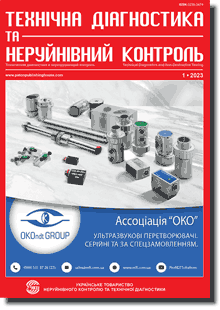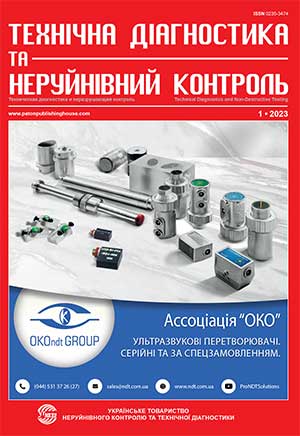| 2023 №01 (04) |
DOI of Article 10.37434/tdnk2023.01.01 |
2023 №01 (02) |

"Tekhnichna Diahnostyka ta Neruinivnyi Kontrol" (Technical Diagnostics and Non-Destructive Testing) #1, 2023, pp. 3-12
Surface EDDY current probes of double differential type as an effective tool to solve non-destructive inspection problems
V.M. Uchanin
G.V. Karpenko Physico-Mechanical Institute of NASU. 5 Naukova str., 79060, Lviv, Ukraine. E-mail: vuchanin@gmail.comA new type of surface eddy current probes of double differential type, which are characterized by increased sensitivity to surface and subsurface defects of various types, is presented. A family of double-differentiation eddy current probes of different diameters with different spatial resolutions has been developed. The paper analyzes the main features of double-differentiation eddy current probes and presents new innovative inspection techniques which allow solving the most complex problems of non-destructive testing. In particular, the developed eddy current probes have been researched and tested as an effective tool of inspection of multi-layered aircraft structures, in which it is necessary to detect internal defects. They provide, in particular, the detection of cracks in the second layer of stratified aircraft structures or cracks on the back surface of the aircraft structures skin; detection of subsurface defects in the weld zone with a rough surface; detection of cracks through repair patches made of aluminum alloy or carbon composite; detection of subsurface cracks near rivet holes, etc. These techniques create unique opportunities for timely detection of dangerous damage without disassembling the inspected object or removing the protective coating. The developed eddy current probes are effective for detecting cracks in ferromagnetic steel products such as forgings, gas turbine blades and shafts, rails, wheels or axles of railway rolling stock, rough-surfaced castings, etc. In addition, high sensitivity to defects can be achieved even during the inspection through an air gap or dielectric coating. This allows them to be successfully used in many automated inspection systems. 17 Ref., 15 Fig.
Keywords: nondestructive testing, eddy current probe of double-differential type, stratified aircraft structure, subsurface defect, repair patches, rivet hole
Received: 23.12.2022
References
1. Libby, H.L. (1971) Introduction to Electromagnetic Non-destructive Test Methods. New-York, etc. Wiley-Interscience.2. McMaster R.C., VcIntire P. (1986) Nondestructive Testing Handbook. Vol. 4: Electromagnetic Testing (Eddy current, Flux leakage and Microwave Nondestructive Testing). Second edition. USA, American Society for NDT.
3. Dorofeev, A.L., Kazamanov, Yu.G. (1980) Electromagnetic flaw detection. Moscow, Mashinostroenie [in Russian].
4. Sobolev, V.S., Shkarlet, Yu.M. (1967) Put-on and screen sensors. Novosibirsk, Nauka [in Russian].
5. Dyakin, V.V., Sandovsky, V.A. (1981) Theory and calculation of put-on eddy-current transducers. Moscow, Nauka [in Russian].
6. Sophian, A., Tian, G., Taylor, D., Rudlin, J. (2001) Electromagnetic and eddy current NDT: a review. Insight, 43(5), 1-5.
7. Kriezis, E.E., Tsiboukis, T.D., Panas, S.M., Tegopoulos, J. (1992) Eddy Currents: Theory and Applications. Proc. of the IEEE, 80(10), 1559-1589. https://doi.org/10.1109/5.168666
8. вачі подвійного диференціювання. Львів, Сполом. Uchanin, V.M. (2013) Eddy-current put-on double differentiation transducers. Lviv, Spolom [in Ukrainian].
9. García-Martín, J., Gómez-Gil, J., Vázquez-Sánchez, E. (2011) Non-destructive techniques based on eddy current testing. Sensors, 11, 2525-2565. https://doi.org/10.3390/s110302525
10. Hagemaier, D.K. (1985) Eddy-current standard depth of penetration. Materials Evaluation, 43(10), 1438-1454.
11. Mottl, Z. (1990) The Quantitative Relations Between True and Standard Depth of Penetration for Air-cored Probe Coils in Eddy-current Testing. NDT International, 23(1), 11-18. https://doi.org/10.1016/0308-9126(90)91444-X
12. Uchanin, V. (2022) Eddy current techniques for detecting hidden subsurface defects in multilayer aircraft structures. Transactions on aerospace research, 267(2), 69-79. https://doi.org/10.2478/tar-2022-0011
13. Uchanin, V. (2020) Detection of the fatigue cracks initiated near the rivet holes by eddy current inspection techniques. Transactions on Aerospace Research, 258(1), 47-58. https://doi.org/10.2478/tar-2020-0010
14. Bachir Bouiadjra, B., Benyahia, F., Albedah, A. et al. (2015) Comparison between composite and metallic patches for repairing aircraft structures of aluminum alloy 7075 T6. Intern. Journ. of Fatigue, 80, 128-135. https://doi.org/10.1016/j.ijfatigue.2015.05.018
15. Bona, A. (2019) Theoretical and experimental review of applied mechanical tests for carbon composites with thermoplastic polymer matrix. Transactions on aerospace research, 4(257), 55-65. https://doi.org/10.2478/tar-2019-0023
16. Mook, G., Michel, F., Simonin, J. (2008) Electromagnetic imaging using probe arrays. Proc. of 17th World Conf. on Nondestructive Testing, Shanghai. www.ndt.net. https://doi.org/10.5545/sv-jme.2010.173
17. Bureau, J.-F., Ward, R.C., Julien, A. (2012) Application of eddy current array technology to surface inspection. Proc. of 18th World Conf. on Nondestructive Testing, Durban, South Africa. www.ndt.net
Advertising in this issue:
The cost of subscription/purchase order journals or individual articles
| Journal/Currency | Annual Set | 1 issue printed |
1 issue |
one article |
| TPWJ/USD | 384 $ | 32 $ | 26 $ | 13 $ |
| TPWJ/EUR | 348 € | 29 € | 24 € | 12 € |
| TPWJ/UAH | 7200 UAH | 600 UAH | 600 UAH | 280 UAH |
| AS/UAH | 1800 UAH | 300 UAH | 300 UAH | 150 UAH |
| AS/USD | 192 $ | 32 $ | 26 $ | 13 $ |
| AS/EUR | 180 € | 30 € | 25 € | 12 € |
| SEM/UAH | 1200 UAH | 300 UAH | 300 UAH | 150 UAH |
| SEM/USD | 128 $ | 32 $ | 26 $ | 13 $ |
| SEM/EUR | 120 € | 30 € | 25 € | 12 € |
| TDNK/UAH | 1200 UAH | 300 UAH | 300 UAH | 150 UAH |
| TDNK/USD | 128 $ | 32 $ | 26 $ | 13 $ |
| TDNK/EUR | 120 € | 30 € | 25 € | 15 € |
AS = «Automatic Welding» - 6 issues per year;
TPWJ = «PATON WELDING JOURNAL» - 12 issues per year;
SEM = «Electrometallurgy Today» - 4 issues per year;
TDNK = «Technical Diagnostics and Non-Destructive Testing» - 4 issues per year.









